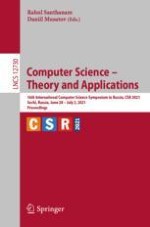2021 | Buch
Computer Science – Theory and Applications
16th International Computer Science Symposium in Russia, CSR 2021, Sochi, Russia, June 28–July 2, 2021, Proceedings
herausgegeben von: Rahul Santhanam, Dr. Daniil Musatov
Verlag: Springer International Publishing
Buchreihe : Lecture Notes in Computer Science
